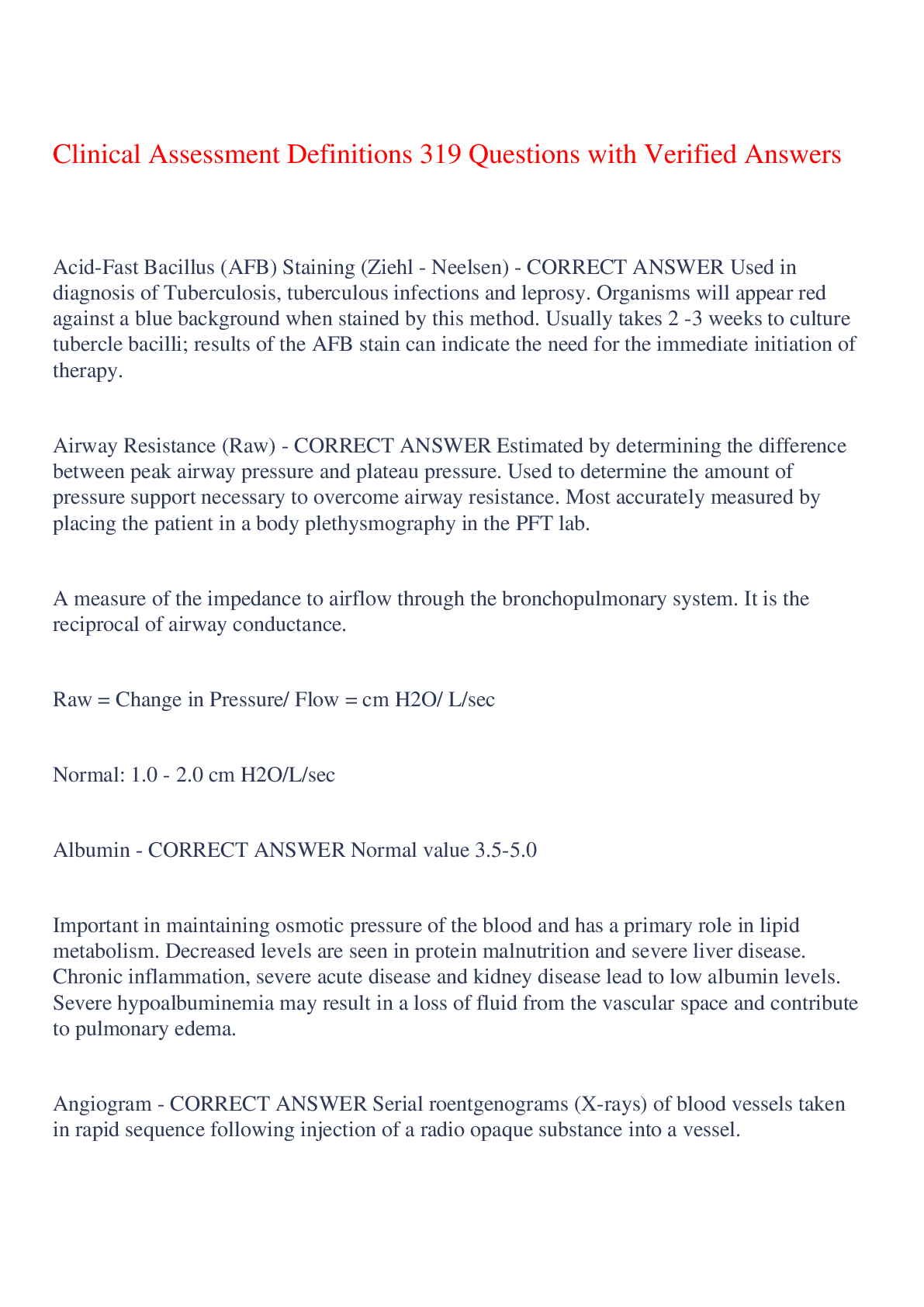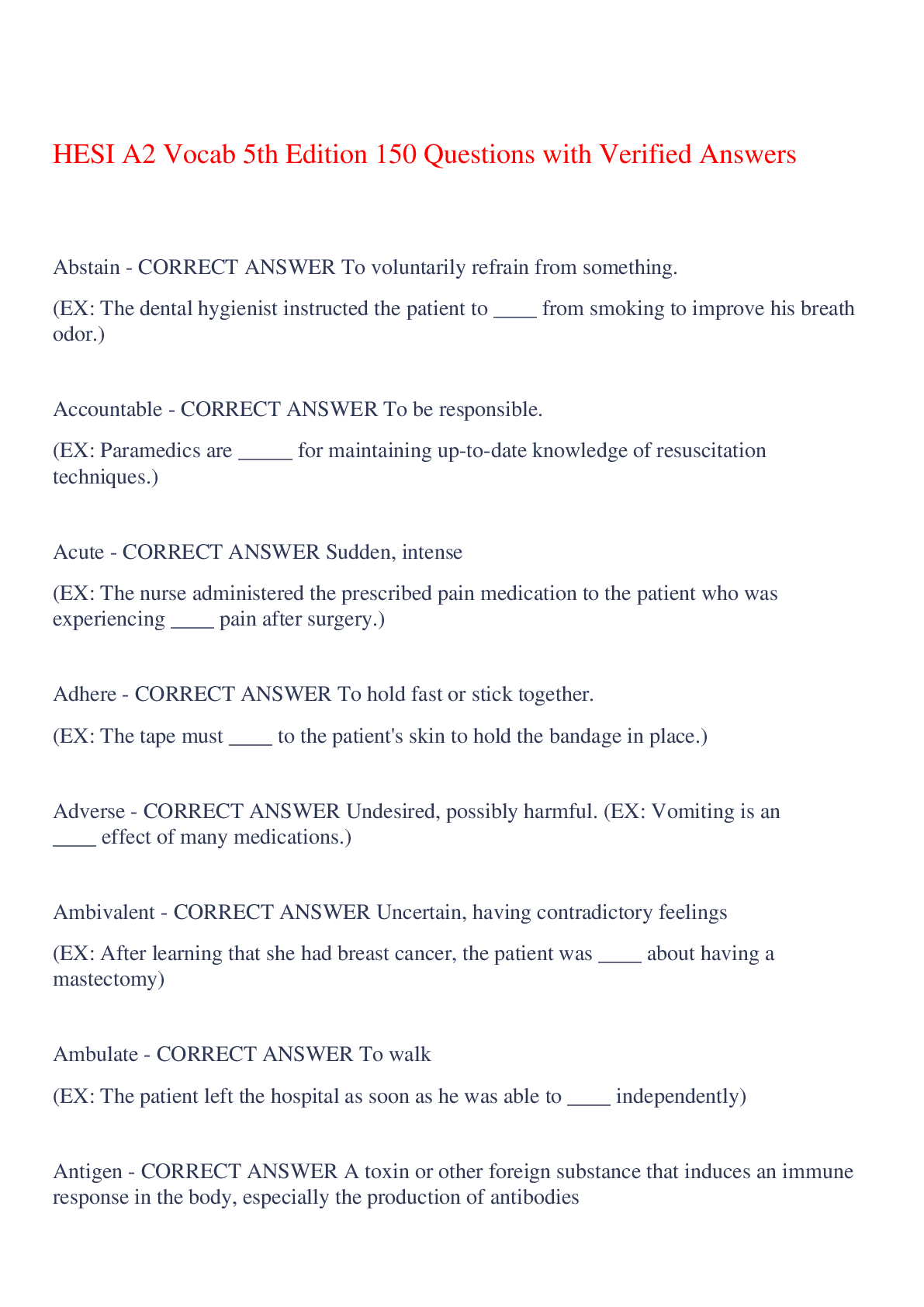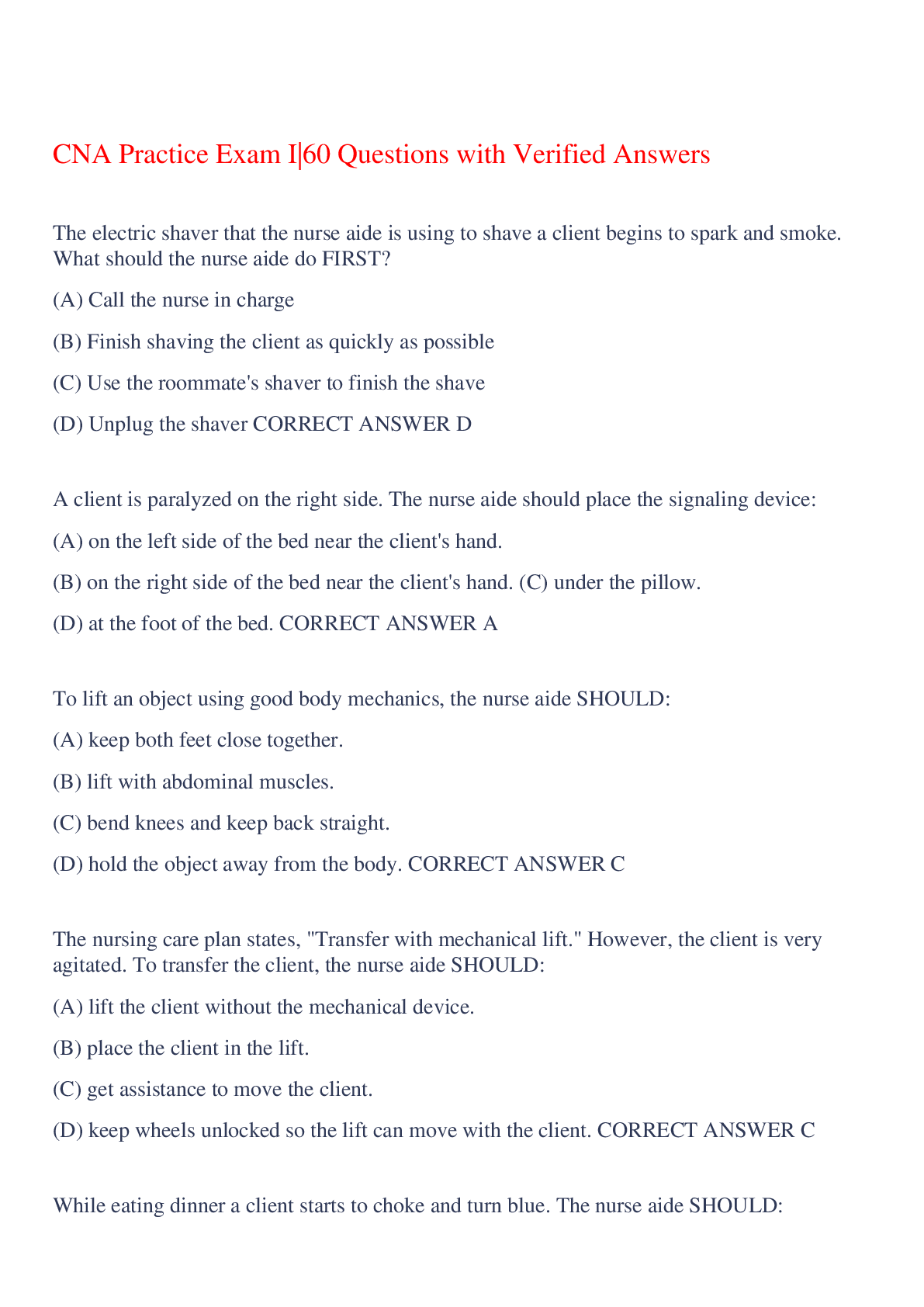*NURSING > EXAM > COM 312 Conflict & Negotiation Exam 48 Questions with Verified Answers,100% CORRECT (All)
COM 312 Conflict & Negotiation Exam 48 Questions with Verified Answers,100% CORRECT
Document Content and Description Below
COM 312 Conflict & Negotiation Exam 48 Questions with Verified Answers 4 characteristics for problematic situations of interpersonal conflict - CORRECT ANSWER Conflicting parties are: Interdepen... dent Perceive they have compatible goals/outcomes (favor incompatible goals to the same extent) Perceived incompatibility has potential to negatively effect relationship if not addressed Posses sense of urgency to resolve the difference Conflict Management - CORRECT ANSWER Communication behavior a person displays based on his or her analysis of a conflict situation Conflict Resolution - CORRECT ANSWER Refers to only one alternative in which parties solve a problem or issue and expect it to arise again Linear Model of Communication - CORRECT ANSWER Sender (a person) sends one message to the receiver (a person) through a channel (pathway) Noise may be a distractor Message intended is not always message received Linear model focus on end result, persuade others to change their mind Transactional Model of Communication - CORRECT ANSWER Exchange of verbal or nonverbal messages in attempt to better understand one another's perspective and create shared meaning End product emphasizes managing and coordinating This view of communication recognizes comm is not something we DO TO one another but something we share WITH others Prelude to Conflict Model - CORRECT ANSWER 1. Prelude to conflict 2. Triggering event 3. Initiation of conflict 4. Differentiation phase 5. Resolution phase Destructive Conflict - CORRECT ANSWER Typical negative view - all conflicts are painful, potentially, and best avoided Productive Conflict - CORRECT ANSWER Positive view - where the effective conflict manager does not view conflict negatively, but rather sees opportunities to resolve problems and improve relationships with the people who mean the most in conflict situations Civility & Respect - CORRECT ANSWER Perceiving conflict as an opportunity to solve problems and improve a relationship should help us better manage many of our conflicts Conflict is Normal! - CORRECT ANSWER Normalizing conflict helps us to better manage it Five Conflict Management Styles - CORRECT ANSWER Competing - Collaborating Compromising Avoiding - Accommodating Tangible Conflict Issues - CORRECT ANSWER Concerns division of material resources Intangible Conflict Issues - CORRECT ANSWER Involve immaterial resources that we value such as love, power, esteem Characteristics of Intangible conflict - CORRECT ANSWER 1. Personality (dominating, selfish, introverted) (global) 2. Relationship Issues (rules, norms, partner boundaries) (global) 3. Behavioral Issues: specific individual boundaries (how we handle money, time, space) Functional Conflict - CORRECT ANSWER 1. Healthy constructive disagreement between two or more people 2. Innovation 3. Realness 4. Solving problems 5. closeness 6. positive change Dysfunctional Conflict - CORRECT ANSWER 1. An unhealthy destructive disagreement between two or more people 2. Wastes resources 3. Diverts energy from work 4. Creates negative climate 5. Breaks down group cohesion 6. Increase hostility & aggressive Dysfunctional Conflict Cycles - CORRECT ANSWER Characteristics 1. Scripts - repeated patterns 2. URPs - Undesired Repetitive Patterns 3. Issues are not resolved Dysfunctional Conflict Cycles - CORRECT ANSWER Three Types 1. Confrontation avoidance/accommodation cycle 2. Competitive conflict escalation cycle 3. Passive-Aggressive cycle Avoidance Cycle - CORRECT ANSWER 1. People avoid conflict 2. People give in to others to avoid conflict 3. Behaviors include - withdrawing, leaving the scene, avoiding discussion of issues, or remaining silent 4. "I don't dare say anything.", "What good would it do to speak up?", "Whatever you decide is okay with me." Communication Apprehension - CORRECT ANSWER 1. may lead to avoidance 2. The level of anxiety a person feels when communicating in either interpersonal, small, or large group settings 3. A person may choose to avoid conflict because she/he experiences communication apprehension Accommodation Cycle - CORRECT ANSWER 1. Smoothing over conflict/not making waves 2. Often benefits other party at personal expense 3. Gunny Sacking - storing up hurts until someone explodes 4. While this cycle is most often dysfunctional there are times when this strategy is the best Accommodation Cycle Steps - CORRECT ANSWER 1. The cycle begins with the belief that confrontation is bad and we should avoid if at all possible. 2. Because we would like to avoid confrontation, experiencing one makes us nervous 3. Generally, something that makes us nervous is something we put off as long as possible 4. Unfortunately, many issues worsen when left alone, so eventually we have to confront them 5. Our anxiety causes us to handle the confrontation badly 6. Our negative perception of conflict is confirmed, and the cycle starts again Competitive Conflict Escalation Cycle - CORRECT ANSWER 1. People so concerned with "winning" they cannot respond to integrative messages 2. Winner takes all approach 3. Pattern is one in which each party tries to "out-do" the other Schismogenesis (the escalation of a cycle) - CORRECT ANSWER occurs when the behaviors of one person intensify the behaviors of another person. Passive Aggressive Communication - CORRECT ANSWER The ability to impose one's will on others through the use of verbal or nonverbal acts that appear to avoid an open conflict or accommodate the desire of others but in actuality are carried out with the intention of inflicting physical or psychological pain, injury, or suffering Compromising Conflict Style - CORRECT ANSWER 1. Determine the needs of the conflicting party 2. If everyone has a fair claim, examine all claims to see if every party can have a fair share 3. If dividing the claim works, give everyone their fair share 4. This is a "middle of the road" approach Collaborating Conflict Style - CORRECT ANSWER 1. Using integrative behaviors and developing mutually satisfying agreements to solve the problem once and for all 2. Integrative behaviors = cooperation, collective action, mutual assistance 3. All partners have in mind and strive for the same goal = win/win outcomes Collaboration - Preferred Approach - CORRECT ANSWER 1. Less competitive 2. Mutual learning and fact finding 3. Allows for exploration 4. Allows for differences in underlying values 5. Resembles "principled" negotiations - focusing on interests rather than positions 6. Allocates responsibility to many parties (not one) 7. Conclusions are participant generated through active, iterative, and reflexive processes 8. Ongoing process 9. Community building potential How to choose a conflict style - CORRECT ANSWER Occasion/Time/Location - Like a situation. An occasion would be the equivalent of a particular book - this mystery, this romance, this thriller, where the time and place create unique expectations that guide our behavior. The Other Person - The realization that people are motivated by their own self-interests means that we have to take them into consideration if we are to gain agreement on solutions to problems and resolution of conflicts. Your Needs - You are an important element in every conflict situation. We must satisfy at least some of our needs if we want to live a life worth living. Skill - CORRECT ANSWER a communication behavior that you learn and can apply in a situation in which is called for Theory - CORRECT ANSWER helps explain how conflict works Psychodynamic Theory - CORRECT ANSWER When people experience conflict from tensions arising from their interpersonal states including: 1. Internal 2. Psychological 3. Emotional 4. Mental Psychodynamic Theory cont... - CORRECT ANSWER Based on work of Sigmund Freud Id - unconscious mind/driven by pleasure Superego - opposes Id and contains ego ideal (ideal for person) and conscience (morals) Ego - Mediates between Id and Superego using "reality principle" Psychodynamic Theory Associated Key Terms - CORRECT ANSWER 1. Anxiety 2. Repression 3. Misplaced Conflicts 4. Frustration 5. Overblown Conflict Psychodynamic Theory cont. - CORRECT ANSWER Helps us explain that: Conflicts that seem to arise "out of nowhere" Attribution Theory - CORRECT ANSWER States that people act as they do in conflict situations because of the interferences they make about others based on their behavior Attribution Theory Associated Key Terms - CORRECT ANSWER 1. Internal attributions 2. External attributions 3. Blaming (others) 4. Attribution error Attribution Theory cont. - CORRECT ANSWER Helps us understand: How people place blame or attribute success that may lead to conflict according to internal vs. external motivations Uncertainty Theory - CORRECT ANSWER Uncertainty in the conflict process occurs when we have insufficient information to understand another's motives, goals, or behaviors or when we do not know the reasons for another's actions Uncertainty Theory Associated Key Terms - CORRECT ANSWER False conflicts - when one person in an interdependent relationship thinks there is a conflict but the other does not Uncertainty Theory cont... - CORRECT ANSWER Helps us understand: Misunderstandings due to lack of information Social Exchange Theory - CORRECT ANSWER states that people evaluate their interpersonal relationships in terms of their value, which is created by the costs and rewards associated with the relationship Social Exchange Theory Associated Key Terms - CORRECT ANSWER 1. Comparison level (CL) 2. Comparison level for alternatives (Clalt) Social Exchange Theory cont... - CORRECT ANSWER Helps us: 1. Better understand how experiences in previous relationships affect conflicts in current relationships 2. We also better appreciate the role alternatives play can play in present relationships Systems Theory - CORRECT ANSWER Acknowledges that rather than conflict being a disruption in a system, it is the normal state of affairs. Conflict is the primary way in which a system adapts to the demands of its environment. So, conflict encourages growth and adaptation of a system. Without conflict, a system faces the possibility of stagnation and decay Systems Theory Associated Key Terms - CORRECT ANSWER Homeostasis - means the system maintains itself in pursuit of a goal Systems Theory cont... - CORRECT ANSWER Helps us understand: Conflict in relationships is a normal part of maintaining relationships when people adjust to new environments Overview for 5 Theories - CORRECT ANSWER Pg. 72 in textbook [Show More]
Last updated: 5 months ago
Preview 1 out of 8 pages
Instant download

Instant download
Reviews( 0 )
Document information
Connected school, study & course
About the document
Uploaded On
Dec 13, 2023
Number of pages
8
Written in
Additional information
This document has been written for:
Uploaded
Dec 13, 2023
Downloads
0
Views
28




























